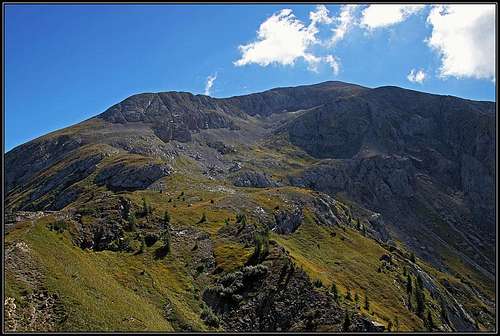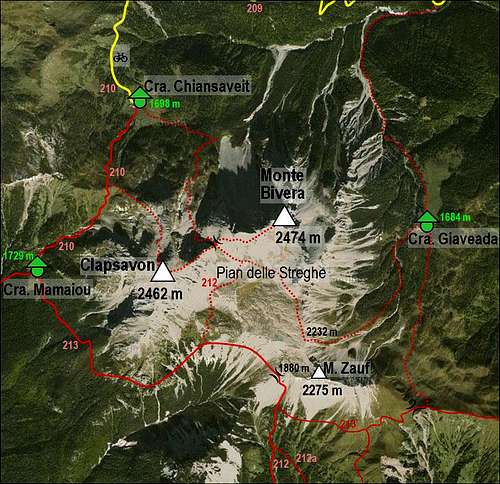-
 5208 Hits
5208 Hits
-
 85.36% Score
85.36% Score
-
 20 Votes
20 Votes
|
|
Mountain/Rock |
|---|---|
|
|
46.43786°N / 12.63153°E |
|
|
Hiking, Mountaineering, Scrambling, Skiing |
|
|
Spring, Summer, Fall, Winter |
|
|
8077 ft / 2462 m |
|
|
Overview
 Ganesh70 - Monte Bivera and Clapsavon
Ganesh70 - Monte Bivera and ClapsavonThe Name
Its origin is a bit uncertain. The first part of the name for sure originates in the Friulian word clap=rock. Savon is perhaps the shortened savalon, meaning sand in Friulian language. The mountain indeed has quite some sand fields on the N and SE side.
Clapsavon Gets Presented
The twin peaks of Monte Bivera and Clapsavon are rising between the valleys of Tagliamento and Sauris. More general description of the area and mountains characteristics can be found on the page of Monte Bivera. Here is only what is characteristic for Clapsavon.
It connects to Monte Bivera with a nice NE ridge, which is a bit sharp on two places, but still allows a not difficult ascent on top. Just before the summit the northern ridge joins and there a small summit plateau is formed. Between the northern ridge and Mote Bivera a high valley lies, filled with scree. There a marked path comes up on Forcella del Bivera, from which both mountains can be climbed. The north-western slopes of Clapsavon are less steep. In the upper part they are covered with gravel, below grass prevails. By those slopes the other, easiest ascent (normal route) comes on top and in winter and spring it's also the route of a ski tour. In the lower part the northern ridge turns towards the north-west and lowers on Forcella Chiansaveit, 2051 m, which allows the north-south passage of the streak. In the valley west of Clapsavon Casera Mamaiou, 1729 m, lies and in the valley north of it Casera Chiansaveit, 1698 m. The latter can be reached by a mountain road, closed for public traffic. The southern and south-eastern slopes of Clapsavon are steep, rugged and intermitted by higher rock sections, so no usual approach goes over them. They are falling deep down in the valley of Tagliamento river. A bit less steep are the S-SW ridge and the W ridge. They both allow easy climbing/scrambling ascents, but there you will find very friable rock. As the approaches from the south are some 1500 meters high, the majority of visitors come on top of Monte Bivera from the northern side, especially because the well known high plateau around Casera di Razzo can be reached from three sides by car.
The ascent on Clapsavon is not hard, neither is it long, so the mountain is often visited. Because we can do a nice round tour and because of the great summit panorama, the ascent on Clapsavon can be highly recommended. The summit panorama is more in detail described on the page of Monte Bivera, where you can find also many pictures. The only difference is, that from the summit of Clapsavon we already see deep down on the villages in Tagliamento river valley.
Geology Outline
Clapsavon rocks are sedimentary, created of sea deposits in Trias - Medium (early period, celled Anisico), before some 237-245 million years. So, these rocks are much older than for example dolomia principale or dachstein limestone, and also much more friable. Any climbing in walls is inadvisable.
Getting There
The most obvious and recommendable point to start the tour on Monte Bivera is Casera di Razzo - a broad alpine meadow in the centre of Carnic region, which can be reached by road from three sides: from Sauris and before it from Tagliamento valley, from Val Pesarina and from Piave river valley. All roads are quite long, but good, except the road above Sauris is occasionally closed because one or two landslides are endagering it. These roads are opened also in late spring, even if on the high area of Casera di Razzo there are no ordinary ski terrains.
The other obvious starting points are trailheads just above the valley of Tagliamento, in the vicinity of Forni di Sotto and Forni di Sopra. From there, the routes on Clapsavon are a bit longer. See the main page of Carnic Alps how to get in Tagliamento valley, in Piave valley and in Val Pesarina! See the parent page of Southern Carnic Alps how to reach the mentioned trailheads!
Routes Overview

1. From Casera di Razzo, 1739 m. By the mountain road we first go almost horizontally on Casera Chiansaveit, 1698 m. There only the real tour starts. The marked path goes right and immediately starts ascending towards Forcella Chiansaveit, 2052 m. Then we go a bit by the ridge and soon afterwards cross on the NW slope. By it the path goes quite comfortably on top. Mostly easy hike-up - by the Swiss (SAC) Hiking Scale the rating would be T2. From Casera Chiansaveit 2 h. This is also the route of a ski tour.
2. North ridge. This is a variant of the ascent from Casera di Razzo. We go to Forcella Chiansaveit, then by the above description to the base of north ridge, there we turn left and ascend on top by the north ridge. Easy scramble on a few places (UIAA I-), one passage UIAA I, a bit exposed.
3. From Forni di Sopra. Forcella Chiansaveit, 1698 m, can be ascended also from Forni di Sopra in 2 h 50 min. In the eastern part of the town we take the path No. 210 and go by it northwards to Casera Mamaiou and then further towards the NE on Forcella Chiansaveit. Then on top as described above.
4. From St. Antonio, west of Forni di Sotto, 832 m. from the main road we go northwards by the path No. 212 or by No. 214, which comes from Forni di Sotto. The higher path later branches, but all three branches finally join below Forcella Rancolin, 1800 m. On the other side of this notch we cross the slopes towards the NW, and then ascend by the path No. 212 up towards the north on Forcella del Bivera and by the NE ridge on top (see below).
5. By the ridge from Monte Bivera (NE). It is very recommendable to combine visits of both summits into one tour. The order is not important. Those who come first on Monte Bivera, will probably reach it from the north and over Forcella del Bivera. From this notch we attack the NE ridge of Clapsavon. After the first steep grassy part we reach a sharp part where on a few meters of crossing we must use hands to come over safely (UIAA I). Then by a nice grassy ridge up again, till the second rocky and also exposed place (UIAA I). After overcoming it carefully, we continue by more and more broad grassy ridge on the summit plateau and on top. By the Swiss (SAC) Hiking Scale the difficulty rating would be T4. 30 min from the notch.
6. S-SW ridge. Advisable for descent, easy scramble (UIAA I-). Ascent from the marked path No. 213 goes from altitude 1800 m. 2 h 30 min.
7. W ridge. Advisable for descent, easy scramble (UIAA I-, one section UIAA I). Ascent from the marked path No. 213 goes from altitude 1750 m, or directly from Casera Montemaggiore (on the map: Casera Mamaiou). 2 h 30 min.
Mountain huts
To visit Clapsavon sleeping on the mountain is not needed. In Forni di Sopra, Forni di Sotto and in Sauris there are many private hotels, higher on the mountain there are shepherds houses, but I don't know if they offer you also to sleep there. As these pastures can be also a goal of simple family hikes you can get food and drinks on some of them.
When to Ascend?
Clapsavon can be ascended almost any time of the year, but most appropriate are the months of summer and autumn - from June till the first snow, which can fall here in November. Beautiful is early summer, when all meadows above Sauris are blossoming. Equally beautiful can be also autumn, when views are more clear. For tour skiing the months from March to May are appropriate, only that in March and April you will only hardly drive up to Casera di Razzo.
Your Help Is Needed
- Do you have any experiences from winter ascents and tour skiing?
- Do you have any detailed information about ascents from the Tagliamento valley side?











